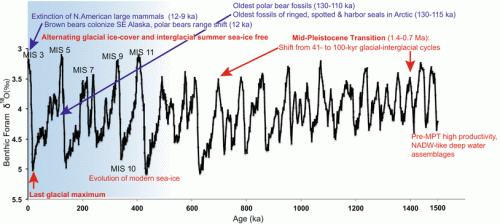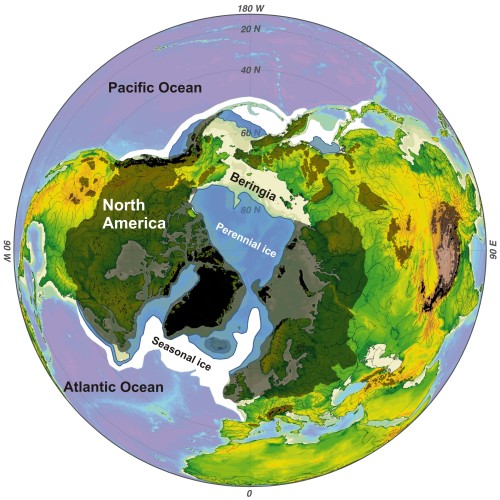Paleoclimate + genetic study confirms: Arctic species adapted to sea ice changes
A new paper that combines paleoclimatology data for the last 56 million years with molecular genetic evidence concludes there were no biological extinctions [of Arctic marine animals] over the last 1.5M years despite profound Arctic sea ice changes that included ice-free summers: polar bears, seals, walrus and other species successfully adapted to habitat changes that exceeded those predicted by USGS and US Fish and Wildlife polar bear biologists over the next 100 years.
Cronin, T. M. and Cronin, M.A. 2015. Biological response to climate change in the Arctic Ocean: the view from the past. Arktos 1:1-18 [Open access] http://link.springer.com/article/10.1007/s41063-015-0019-3
Thomas Cronin is a USGS paleoclimatologist at the Eastern Geology and Paleoclimate Science Center, and Matthew Cronin is a molecular geneticist at the University of Alaska Fairbanks (see previous posts here and here about Matt’s work on the genetics of polar bear evolution).
From the Abstract:
Arctic climatic extremes include 25°C hyperthermal periods during the Paleocene-Eocene (56–46 million years ago, Ma), Quaternary glacial periods when thick ice shelves and sea ice cover rendered the Arctic Ocean nearly uninhabitable, seasonally sea-ice-free interglacials and abrupt climate reversals.The final discussion and two summary graphics from this paper (copied below) are especially useful:
The Cenozoic ecosystem changes in the Arctic described above are summarized in Figs. 5 and 6 within the context of climate changes over different timescales. Several conclusions can be made.Cronin and Cronin 2015 Fig. 5: Summary of Arctic Ocean biological and climatic events during the Cenozoic. Blue letters are marine mammal events, red are climatic events, green are biological events. See text and Supplementary Tables 1–3 and Supplementary references for sources.
First, a seasonally ice-free marginal and central Arctic Ocean was common not only during Greenhouse worlds of PETM and Early Eocene, but also during the Pliocene, the early Quaternary before the Mid-Pleistocene Transition, during MIS 11, MIS 5 and regionally during the early Holocene.
During orbital climatic cycles of the last few hundred thousand years, interglacial periods were characterized by perennial and at times seasonal sea ice cover and inhabited by marine ecosystems similar to those of the pre-industrial Holocene. Some species thought to be dependent on summer sea ice (e.g., polar bears) survived through these periods.
In contrast, during glacial periods the much smaller Arctic Ocean and much of the adjacent continents were covered with massive ice sheets, thick ice shelves, and sea ice making large regions virtually uninhabitable to most species that inhabit today’s Arctic.
Despite the scale, frequency and rapidity of Quaternary climate changes, Arctic marine ecosystems associated with sea-ice habitats were extremely resilient, adapting through geographic range expansion into the Arctic during warm periods, and south into extra-Arctic regions during glacial periods. The stratigraphic record of the last 1.5 Ma indicates that no marine species’ extinction events occurred despite major climate oscillations.
The Cenozoic sedimentary record is too incomplete to conclude that large climate transitions caused extinction of Arctic species, but hopefully future IODP coring will recover more complete records. More generally, future cross-discipline studies of Arctic species and ecosystems combining molecular methods and paleoclimate reconstructions will result in a better understanding of how biological systems respond to climate changes. [my bold]

Cronin and Cronin 2015 Fig. 6: Summary of Arctic Ocean biological and climatic events during mid-to-late Quaternary orbital glacial-interglacial cycles. Blue letters are marine mammal events, red are climatic events, green are biological events. See text and Supplementary Tables 1–3 and Supplementary references for sources

——————————
Compare above to my previous post here on my estimate of sea ice coverage at the height of the last Ice Age (Last Glacial Maximum, copied below):

Figure
2. Approximate sea ice extent at the Last Glacial Maximum: blue is
perennial sea ice (present year round) and white is seasonal sea ice at
its maximum (late winter). Purple is open ocean; black and dark grey are
continental ice sheets; cream areas are land bridges exposed by lower
sea level. Sea ice added by J.F. Baichtal, from this image, labels added by SJ Crockford. Click to enlarge.

No comments:
Post a Comment